
Lizard is the common name used for all squamate reptiles other than snakes, encompassing over 7,000 species, ranging across all continents except Antarctica, as well as most oceanic island chains. The grouping is paraphyletic as some lizards are more closely related to snakes than they are to other lizards. Lizards range in size from chameleons and geckos a few centimeters long to the 3-meter-long Komodo dragon.

Squamata is the largest order of reptiles, comprising lizards and snakes. With over 12,162 species, it is also the second-largest order of extant (living) vertebrates, after the perciform fish. Squamates are distinguished by their skins, which bear horny scales or shields, and must periodically engage in molting. They also possess movable quadrate bones, making possible movement of the upper jaw relative to the neurocranium. This is particularly visible in snakes, which are able to open their mouths very widely to accommodate comparatively large prey. Squamates are the most variably sized living reptiles, ranging from the 16 mm (0.63 in) dwarf gecko to the 6.5 m (21 ft) reticulated python. The now-extinct mosasaurs reached lengths over 14 m (46 ft).

The Lizard is a character appearing in American comic books published by Marvel Comics. Created by Stan Lee and Steve Ditko, he first appeared in The Amazing Spider-Man #6 as an enemy of the superhero Spider-Man. While the character has retained this role throughout most of his subsequent appearances, he has also been portrayed as a tragic antihero and occasional ally of Spider-Man. Connors is sometimes an ally of Spider-Man just as himself, and not necessarily as his alter ego.

Monitor lizards are lizards in the genus Varanus, the only extant genus in the family Varanidae. They are native to Africa, Asia, and Oceania, and one species is also found in the Americas as an invasive species. About 80 species are recognized.

Latastia is a genus of lizards of the family Lacertidae. Species of this genus are distributed in Africa but one subspecies lives in Yemen. Collectively, they are known as long-tailed lizards.

Wilhelm Karl HartwichPeters was a German naturalist and explorer.
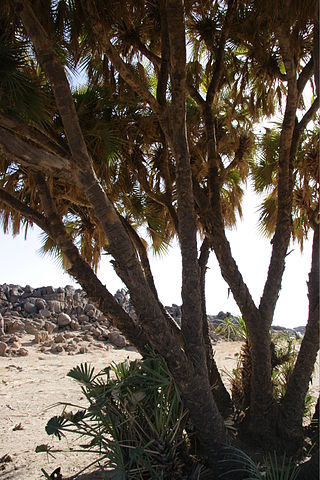
Hyphaene is a genus of palms native to Africa, Madagascar, the Middle East, and the Indian subcontinent.
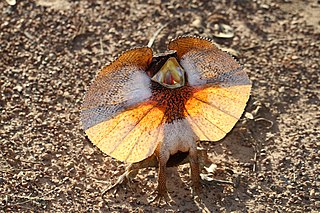
The frilled lizard, also known commonly as the frilled agama, the frillneck lizard, the frill-necked lizard, and the frilled dragon, is a species of lizard in the family Agamidae. The species is native to northern Australia and southern New Guinea. This species is the only member of the genus Chlamydosaurus. Its common names refer to the large frill around its neck, which usually stays folded against the lizard's body. The frilled lizard grows to 90 cm (35 in) from head to tail tip and can weigh 600 g (1.3 lb). Males are larger and more robust than females. The lizard's body is generally grey, brown, orangish-brown, or black in colour. The frills have red, orange, yellow, or white colours.
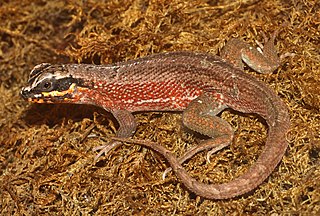
Iguania is an infraorder of squamate reptiles that includes iguanas, chameleons, agamids, and New World lizards like anoles and phrynosomatids. Using morphological features as a guide to evolutionary relationships, the Iguania are believed to form the sister group to the remainder of the Squamata, which comprise nearly 11,000 named species, roughly 2000 of which are iguanians. However, molecular information has placed Iguania well within the Squamata as sister taxa to the Anguimorpha and closely related to snakes. The order has been under debate and revisions after being classified by Charles Lewis Camp in 1923 due to difficulties finding adequate synapomorphic morphological characteristics. Most iguanians are arboreal but there are several terrestrial groups. They usually have primitive fleshy, non-prehensile tongues, although the tongue is highly modified in chameleons. Today they are scattered occurring in Madagascar, the Fiji and Friendly Islands and Western Hemisphere.
Monkey pod is a common name for several plants and may refer to:
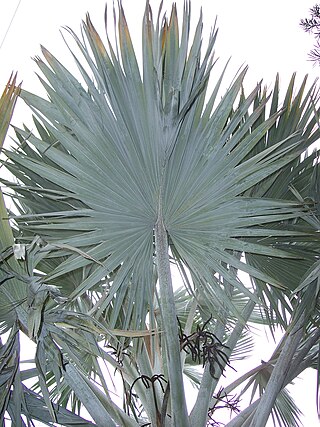
Fan palm as a descriptive term can refer to any of several different kinds of palms (Arecaceae) in various genera with leaves that are palmately lobed. Most are members of the subfamily Coryphoideae, though a few genera in subfamily Calamoideae also have palmate leaves. Fan palm genera include:

Willughbeia is a genus of plant in the family Apocynaceae, first described as a genus in 1820. It is native to Southeast Asia with a few species in the Indian Subcontinent. Several species have edible fruits enjoyed in many countries. Many species are vines with sticky latex.

Nymphaea nouchali, often known by its synonym Nymphaea stellata, or by common names blue lotus, star lotus, red water lily, dwarf aquarium lily, blue water lily, blue star water lily or manel flower, is a water lily of genus Nymphaea. It is native to southern and eastern parts of Asia, and is the national flower of Bangladesh and Sri Lanka. In Sanskrit it is called utpala. This species is usually considered to include the blue Egyptian lotus N. nouchali var. caerulea. In the past, taxonomic confusion has occurred, with the name Nymphaea nouchali incorrectly applied to Nymphaea pubescens.
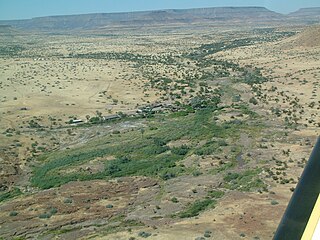
Palmwag is a veterinary control point, an oasis and a tourism concession area on communal land in northern Namibia. It is located in the Kunene region on the Uniab River, in northwestern Damaraland, halfway between Swakopmund and the Etosha National Park. It covers an area of 400,000 hectares and has populations of Hyphaena petersiana. Palmwag is situated on the Red Line, a veterinary cordon fence separating northern Namibia from the rest of the country.

Hyphaene petersiana, the real fan palm or makalani palm, is a palm tree native to the subtropical, low-lying regions of south central Africa.

Bauhinia petersiana, the Kalahari white bauhinia, is a species of shrubs from family Fabaceae found in Botswana, Zambia, Democratic Republic of Congo, Lesotho, Mozambique, Angola, Namibia, Tanzania, South Africa, and Zimbabwe. The species is 2 metres in height.

Senna petersiana, the monkey pod or eared senna, is an African deciduous shrub or small tree. The leaves are compound with about 12 opposite lanceolate leaflets, dark green above and lighter below. Its copious bright yellow flowers are carried on erect multi-branched inflorescences. The species was formerly placed in the genus Cassia.

Ancylobothrys petersiana grows as a climbing shrub up to 6 metres (20 ft) tall. Its fragrant flowers feature a creamy or white corolla. Fruit is spherical, up to 6 centimetres (2.4 in) in diameter. Vernacular names include "climbing wild apricot". Habitat is woodland and rocky hillsides. A. petersiana is found in the Democratic Republic of Congo, Burundi, Somalia, Kenya, Tanzania, Malawi, Mozambique, Zimbabwe, South Africa, the Comoros and Madagascar.

King Gizzard & the Lizard Wizard (KGLW) are an Australian rock band formed in 2010 in Melbourne, Victoria. The band's current lineup consists of Stu Mackenzie, Ambrose Kenny-Smith, Cook Craig, Joey Walker, Lucas Harwood, and Michael Cavanagh. They are known for exploring multiple genres, staging energetic live shows, and building a prolific discography.
Nymphaea nouchali var. petersiana is a variety of the water lily species Nymphaea nouchali Burm.f. native to the region spanning from Tanzania to South Africa.

















